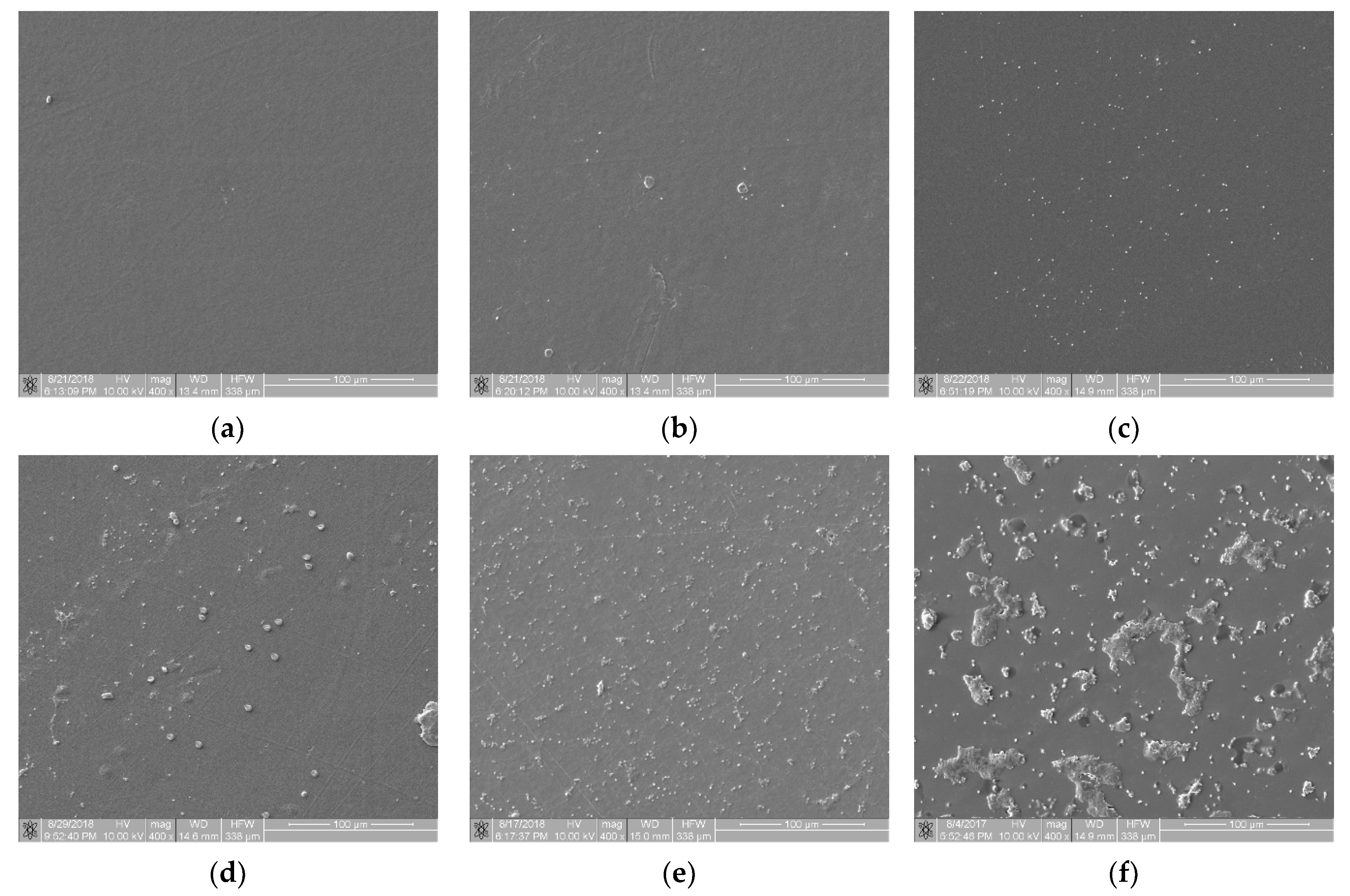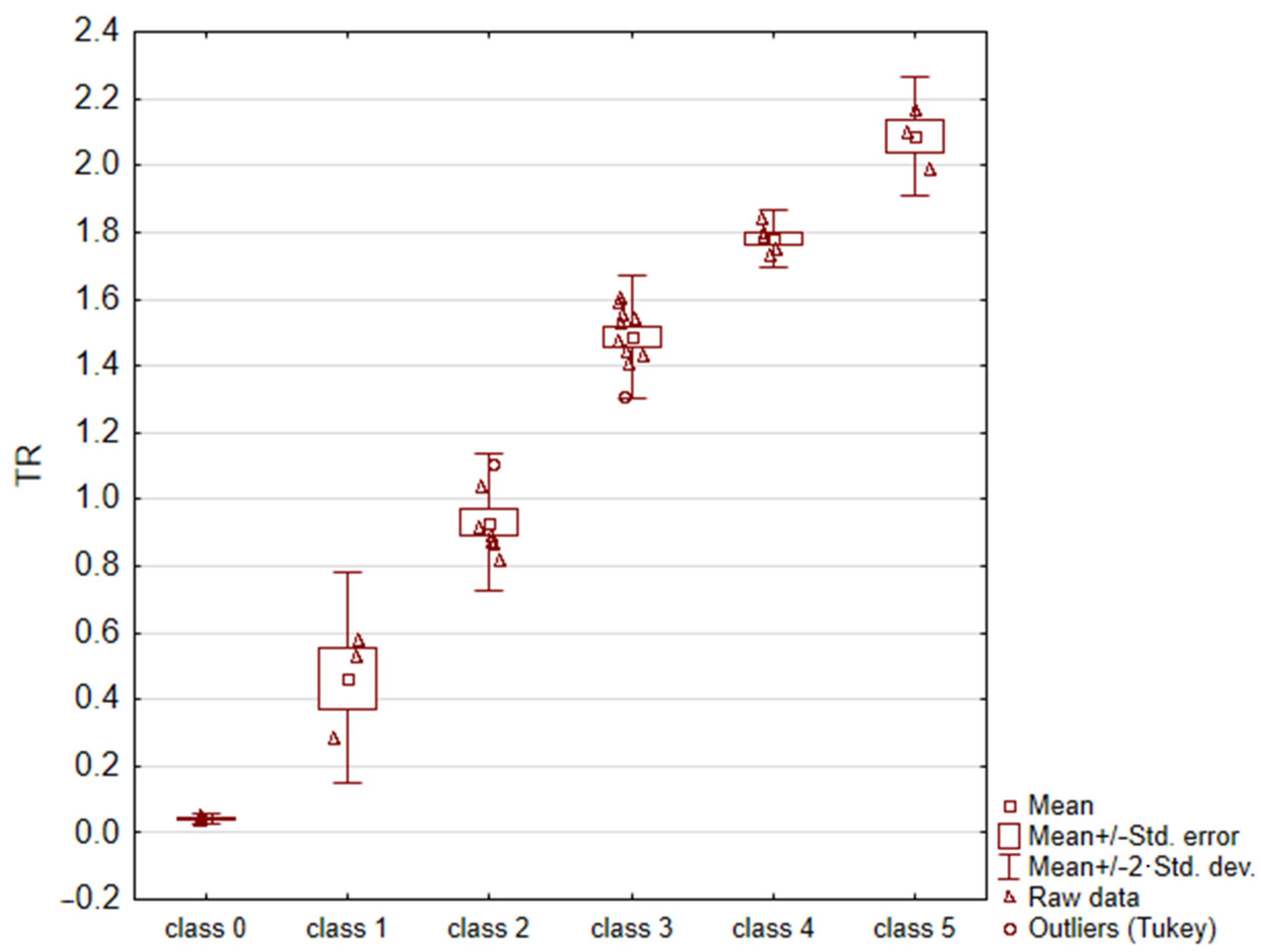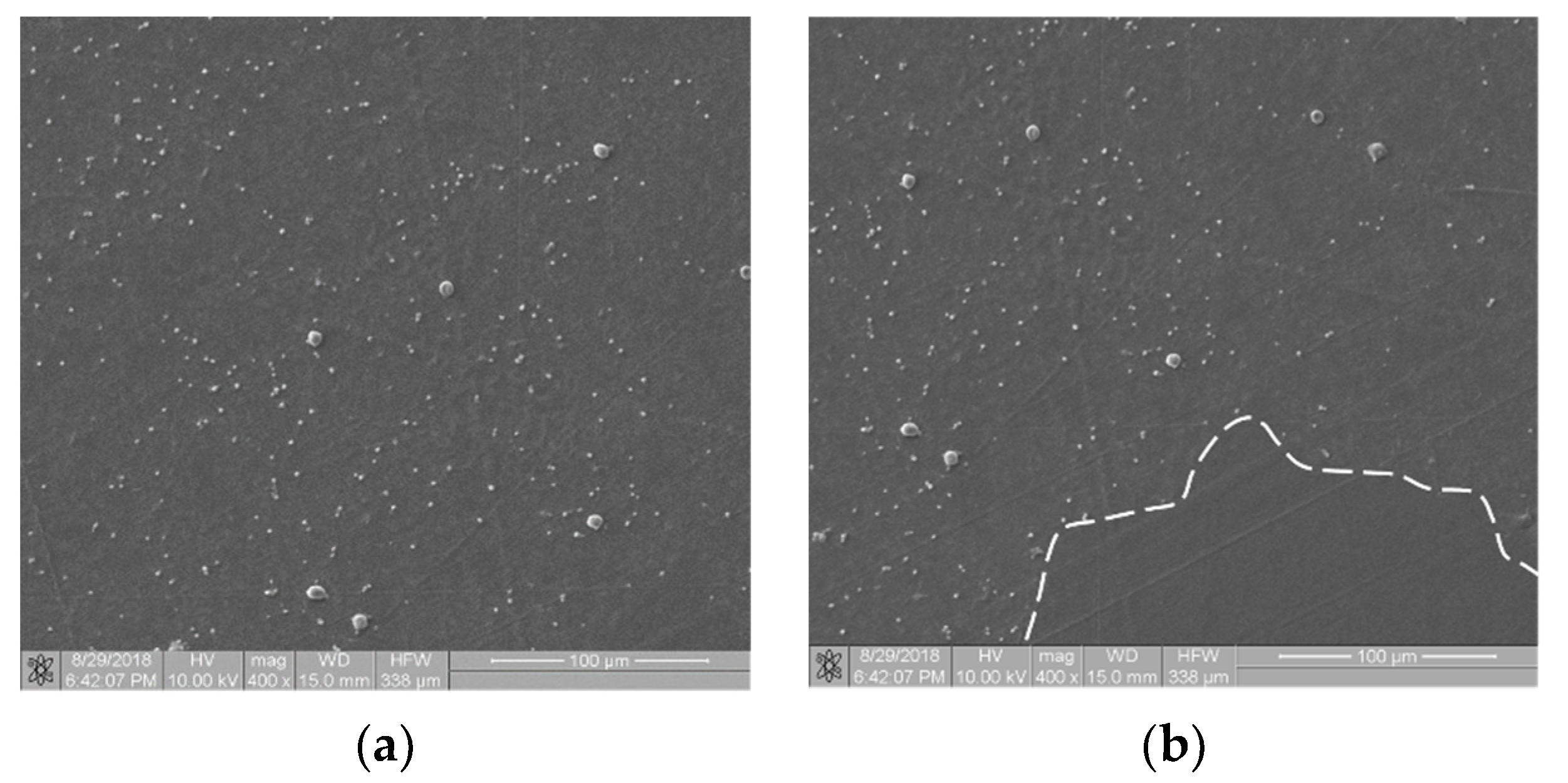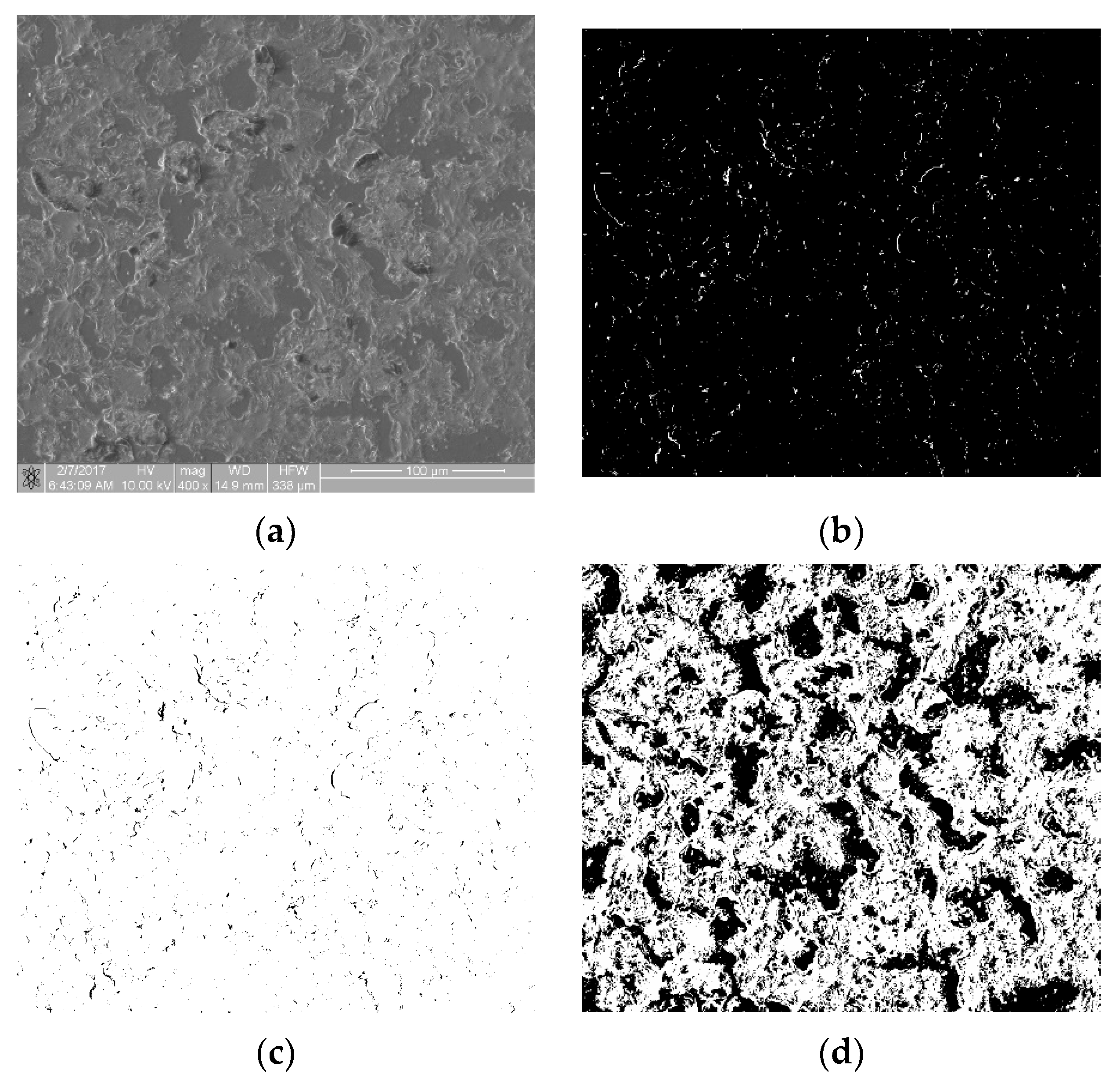Semi-Quantitative Method of Assessing the Thrombogenicity of Biomaterials Intended for Long-Term Blood Contact
Abstract
1. Introduction
2. Material and Methods
2.1. Materials
2.2. Sample Preparation
2.3. Blood Donation and Platelet-Rich Plasma Preparation
2.4. Course of Experiment
2.5. Image Acquisition and Pre-Processing
2.6. Calculation of Fractal Dimension
2.7. Final Statistical Analysis
- Outliers were detected with Tukey’s quartile method and removed from the statistics.
- The normality of the sample distribution was tested with the Shapiro–Wilk test at a significance level of p = 0.05 (a statistically significant test result indicates no normal data distribution).
- In the case of normal distribution, the thrombogenicity of each sample was quantified as the mean value of the TR parameters with a confidence interval of 0.95.
- In the case of an abnormal distribution, the data were analyzed with non-parametric equivalents of parametric tests: the Kruskal–Wallis’ test for the analysis of variance and the Mann–Whitney U test for the Student’s t-test.
3. Results
3.1. Determination of TR Parameter for Samples with Different Levels of Thrombogenicity
- Class 0 (n = 3) contained samples with a minimal degree of thrombogenicity: separated platelets of a low diversity level and a lack of platelet aggregates (Figure 3a);
- Class 1 (n = 3) contained samples with a very low degree of thrombogenicity: a dozen or so adhered blood platelets that did not form aggregates (Figure 3b);
- Class 2 (n = 7) contained samples with a low degree of thrombogenicity: several dozen visible platelets that could form single, separated aggregates of a small area (Figure 3c);
- Class 3 (n = 10) contained samples with an average degree of thrombogenicity: the biological material mainly comprised aggregates that showed a greater degree of thrombogenicity than that of individual platelets (Figure 3d);
- Class 4 (n = 5) contained samples with a high degree of thrombogenicity: the sample was covered with highly differentiated biological material and the individual objects were usually connected with each other, which made it impossible to separate them (Figure 3e);
- Class 5 (n = 3) contained samples with a very high degree of thrombogenicity: platelets were highly differentiated and formed numerous aggregates connected to each other, which made it impossible to separate and count objects (Figure 3f).
3.2. The Influence of the Unique Features of the Image on the Value of the TR Coefficient
3.3. Boundary Cases
4. Discussion and Conclusions
Supplementary Materials
Author Contributions
Funding
Institutional Review Board Statement
Informed Consent Statement
Data Availability Statement
Acknowledgments
Conflicts of Interest
References
- Virani, S.S.; Alonso, A.; Benjamin, E.J.; Bittencourt, M.S.; Callaway, C.W.; Carson, A.P.; Chamberlain, A.M.; Chang, A.R.; Cheng, S.; Delling, F.N.; et al. Heart Disease and Stroke Statistics—2020 Update: A Report From the American Heart Association. Circulation 2020, 141, e139–e596. [Google Scholar] [CrossRef] [PubMed]
- Kannojiya, V.; Das, A.K.; Das, P.K. Comparative assessment of different versions of axial and centrifugal LVADs: A review. Artif. Organs 2021, 45, 665–681. [Google Scholar] [CrossRef] [PubMed]
- Shao, Z.; Tao, T.; Xu, H.; Chen, C.; Lee, I.S.; Chung, S.; Dong, Z.; Li, W.; Ma, L.; Bai, H.; et al. Recent progress in biomaterials for heart valve replacement: Structure, function, and biomimetic design. View 2021, 2, 20200142. [Google Scholar] [CrossRef]
- Han, Q.; Shea, S.M.; Arleo, T.; Qian, J.Y.; Ku, D.N. Thrombogenicity of biomaterials depends on hemodynamic shear rate. Artif. Organs 2022, 46, 606–617. [Google Scholar] [CrossRef]
- Braune, S.; Latour, R.A.; Reinthaler, M.; Landmesser, U.; Lendlein, A.; Jung, F. In Vitro Thrombogenicity Testing of Biomaterials. Adv. Healthc. Mater. 2019, 8, 1900527. [Google Scholar] [CrossRef]
- Xu, Y.; Yu, G.; Nie, R.; Wu, Z. Microfluidic systems toward blood hemostasis monitoring and thrombosis diagnosis: From design principles tomicro/nano fabrication technologies. View 2022, 3, 20200183. [Google Scholar] [CrossRef]
- Odziomek, K.; Ushizima, D.; Oberbek, P.; Kurzydłowski, K.J.; Puzyn, T.; Haranczyk, M. Scanning electron microscopy image representativeness: Morphological data on nanoparticles. J. Microsc. 2017, 265, 34–50. [Google Scholar] [CrossRef]
- Bruinink, A.; Luginbuehl, R. Evaluation of Biocompatibility Using In Vitro Methods: Interpretation and Limitations. In Tissue Engineering III: Cell-Surface Interactions for Tissue Culture; Kasper, C., Witte, F., Pörtner, R., Eds.; Springer: Berlin/Heidelberg, Germany, 2012; pp. 117–152. [Google Scholar] [CrossRef]
- Lippi, G.; Favaloro, E.J. Laboratory hemostasis: From biology to the bench. Clin. Chem. Lab. Med. 2018, 56, 1035–1045. [Google Scholar] [CrossRef]
- Sanak, M.; Jakieła, B.; Węgrzyn, W. Assessment of hemocompatibility of materials with arterial blood flow by platelet functional tests. Bull. Pol. Acad. Sci. Tech. Sci. 2010, 58, 317–322. [Google Scholar] [CrossRef][Green Version]
- Sarode, D.N.; Roy, S. In Vitro models for thrombogenicity testing of blood-recirculating medical devices. Expert Rev. Med. Devices 2019, 16, 603–616. [Google Scholar] [CrossRef]
- Goncalves, M.S.T. Fluorescent Labeling of Biomolecules with Organic Probes. Chem. Rev. 2009, 109, 190–212. [Google Scholar] [CrossRef] [PubMed]
- Diaspro, A.; Chirico, G.; Usai, C.; Ramoino, P.; Dobrucki, J. Photobleaching. In Handbook Of Biological Confocal Microscopy; Pawley, J.B., Ed.; Springer: Boston, MA, USA, 2006; pp. 690–702. [Google Scholar] [CrossRef]
- Gawlikowski, M.; El Fray, M.; Janiczak, K.; Zawidlak-Węgrzyńska, B.; Kustosz, R. In-Vitro Biocompatibility and Hemocompatibility Study of New PET Copolyesters Intended for Heart Assist Devices. Polymers 2020, 12, 2857. [Google Scholar] [CrossRef] [PubMed]
- Fathi-Karkan, S.; Banimohamad-Shotorbani, B.; Saghati, S.; Rahbarghazi, R.; Davaran, S. A critical review of fibrous polyurethanebased vascular tissue engineering scaffolds. J. Biol. Eng. 2022, 16, 1824. [Google Scholar] [CrossRef] [PubMed]
- Ma, R.; Tang, T. Current Strategies to Improve the Bioactivity of PEEK. Int. J. Mol. Sci. 2014, 15, 5426–5445. [Google Scholar] [CrossRef] [PubMed]
- Farndale, R.W. Collagen-induced platelet activation. Blood Cells Mol. Dis. 2006, 36, 162–165. [Google Scholar] [CrossRef]
- Dhurat, R.; Sukesh, M.S. Principles and methods of preparation of platelet-rich plasma: A review and author′s perspective. J. Cutan. Aesthetic Surg. 2014, 7, 189. [Google Scholar] [CrossRef]
- Prewitt, J.M.S.; Mendelsohn, M.L. The Analysis Of Cell Images. Ann. N. Y. Acad. Sci. 1966, 128, 1035–1053. [Google Scholar] [CrossRef]
- Otsu, N. A Threshold Selection Method from Gray-Level Histograms. IEEE Trans. Syst. Man Cybern. 1979, 9, 62–66. [Google Scholar] [CrossRef]
- Mavrogonatos, A.; Papia, E.M.; Dimitrakellis, P.; Constantoudis, V. Measuring the randomness of micro– and nanostructure spatial distributions: Effects of scanning electron microscope image processing and analysis. J. Microsc. 2022, 37, 48–57. [Google Scholar] [CrossRef]
- Peitgen, H.O.; Jurgens, H.; Saupe, D. Chaos and Fractals: New Frontiers of Science; Springer: New York, NY, USA, 1992. [Google Scholar]
- Falconer, K. (Ed.) Fractal Geometry; JohnWiley & Sons, Ltd.: Chichester, UK, 2003. [Google Scholar] [CrossRef]
- Wu, J.; Jin, X.; Mi, S.; Tang, J. An effective method to compute the box-counting dimension based on the mathematical definition and intervals. Results Eng. 2020, 6, 100106. [Google Scholar] [CrossRef]
- Jelinek, H.F.; Jones, C.L.; Warfel, M.D.; Lucas, C.; Depardieu, C.; Aurel, G. Understanding Fractal Analysis? The Case of Fractal Linguistics. Complexus 2006, 3, 66–73. [Google Scholar] [CrossRef]









| Box Size δ (Pixels) | 2 | 3 | 4 | 6 | 8 | 12 | 16 | 32 | 64 |
|---|---|---|---|---|---|---|---|---|---|
| N(δ) | 13,011 | 8666 | 6606 | 4642 | 3737 | 2639 | 2072 | 844 | 224 |
| log(δ) | 0.301 | 0.477 | 0.602 | 0.778 | 0.903 | 1.079 | 1.204 | 1.505 | 1.806 |
| log(N(δ)) | 4.114 | 3.938 | 3.820 | 3.667 | 3.573 | 3.421 | 3.316 | 2.926 | 2.350 |
| Parameter | Value | Standard Error | p |
|---|---|---|---|
| intercept | 4.513 | 0.180 | 0.000 |
| slope | −1.097 | 0.073 | 0.000 |
| R2 | 0.984 | 0.9698 | 0.001 |
| D = ABS(slope) | 1.097 | 0.073 | 0.000 |
| TRN = eD − 1 | 1.995 | −0.227/+0.211 |
| Class of Thrombogenicity | Sample Size n | Mean TR | Upper Confidence Interval | Lower Confidence Interval |
|---|---|---|---|---|
| class 0 | 3 | 0.043 | 0.024 | 0.061 |
| class 1 | 3 | 0.465 | 0.071 | 0.858 |
| class 2 | 7 | 0.930 | 0.835 | 1.026 |
| class 3 | 10 | 1.488 | 1.422 | 1.554 |
| class 4 | 5 | 1.783 | 1.729 | 1.837 |
| class 5 | 3 | 2.087 | 1.867 | 2.307 |
| Parameter | Value | Standard Error | p |
|---|---|---|---|
| Intercept | 1.479 | 0.153 | 0.000 |
| Slope | 0.432 | 0.062 | 0.000 |
| R2 | 0.854 | 0.199 | 0.000 |
| D = ABS(slope) | 0.432 | 0.062 | 0.000 |
| TRN = eD − 1 | 0.541 | −0.098/+0.093 |
Disclaimer/Publisher’s Note: The statements, opinions and data contained in all publications are solely those of the individual author(s) and contributor(s) and not of MDPI and/or the editor(s). MDPI and/or the editor(s) disclaim responsibility for any injury to people or property resulting from any ideas, methods, instructions or products referred to in the content. |
© 2022 by the authors. Licensee MDPI, Basel, Switzerland. This article is an open access article distributed under the terms and conditions of the Creative Commons Attribution (CC BY) license (https://creativecommons.org/licenses/by/4.0/).
Share and Cite
Gawlikowski, M.; Major, R.; Mika, B.; Komorowski, D.; Janiczak, K.; Tkacz, E.; Tamulewicz, A.; Piaseczna, N. Semi-Quantitative Method of Assessing the Thrombogenicity of Biomaterials Intended for Long-Term Blood Contact. Materials 2023, 16, 38. https://doi.org/10.3390/ma16010038
Gawlikowski M, Major R, Mika B, Komorowski D, Janiczak K, Tkacz E, Tamulewicz A, Piaseczna N. Semi-Quantitative Method of Assessing the Thrombogenicity of Biomaterials Intended for Long-Term Blood Contact. Materials. 2023; 16(1):38. https://doi.org/10.3390/ma16010038
Chicago/Turabian StyleGawlikowski, Maciej, Roman Major, Barbara Mika, Dariusz Komorowski, Karolina Janiczak, Ewaryst Tkacz, Anna Tamulewicz, and Natalia Piaseczna. 2023. "Semi-Quantitative Method of Assessing the Thrombogenicity of Biomaterials Intended for Long-Term Blood Contact" Materials 16, no. 1: 38. https://doi.org/10.3390/ma16010038
APA StyleGawlikowski, M., Major, R., Mika, B., Komorowski, D., Janiczak, K., Tkacz, E., Tamulewicz, A., & Piaseczna, N. (2023). Semi-Quantitative Method of Assessing the Thrombogenicity of Biomaterials Intended for Long-Term Blood Contact. Materials, 16(1), 38. https://doi.org/10.3390/ma16010038






